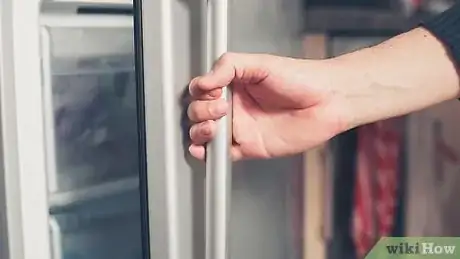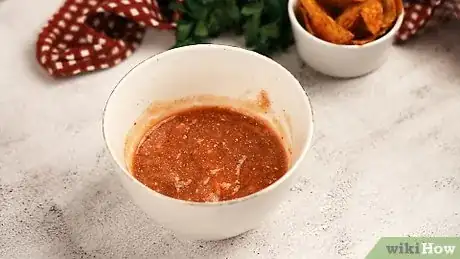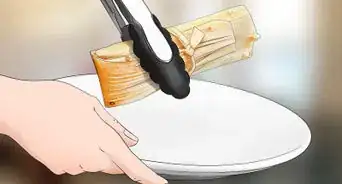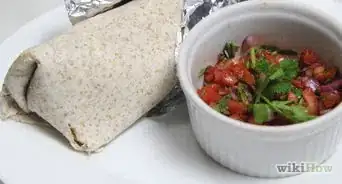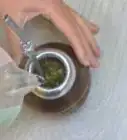This article was co-authored by Marrow Private Chefs. Marrow Private Chefs are based in Santa Rosa Beach, Florida. It is a chefs’ collaborative comprised of an ever-growing number of chefs and culinary professionals. Though regionally influenced primarily by coastal, traditional southern, cajun, and creole styles and flavors, the chefs at Marrow have a solid background in all types of cuisine with over 75 years of combined cooking experience.
There are 9 references cited in this article, which can be found at the bottom of the page.
This article has been viewed 120,641 times.
Whether you forgot to deseed your peppers or used a tablespoon of cayenne instead of a teaspoon, making salsa too spicy is an easy mistake. However, there’s no need to throw out your dish if tasting it left you with flames shooting from your ears. Try adding cooling ingredients like citrus juice, fruit, or dairy. If you don’t want to get experimental, just make another batch without the spicy ingredients, then combine it with the original batch. You’ll have twice as much salsa as you planned for, but you can easily can or freeze any leftovers.
Steps
Taming the Heat
-
1Add more tomato to red salsas. If your salsa is tomato-based, just add a little more chopped tomato. As with any additional ingredient, the amount needed will depend on the size of your batch and how mild you need it to be.[1]
- Try adding half a tomato for starters, then add more to taste.
- Keep a glass of milk handy to cool off after your taste tests!
-
2Grab some citrus, sugar, or honey. Adding acid and sweetness are well known ways to tame a spicy dish. Try squeezing in the juice of a quarter lime and a half teaspoon of sugar or honey.[2]
- Remember you can always add more, so mix in additional flavors little by little and taste as you go.
Advertisement -
3Mix in a cilantro and citrus puree. Cilantro and citrus were probably in your original recipe, so adding a little more will help you tone down your salsa without changing it too dramatically. Strip the leaves from a dozen or so cilantro sprigs, chop them coarsely, then blend them with the juice or a lime or an orange.[3]
- Add a teaspoon at a time until you’ve gotten your salsa under control. If you have any leftover, it’ll make a great condiment for tacos, sandwiches, eggs, and stir fries.
-
4Try chopped cucumber or avocado. Get your salsa cool as a cucumber! Adding cucumber or avocado can ease the heat but, if they weren’t in the original recipe, they might change your salsa’s texture and flavor. If you’re open to a little experimentation, chop up one or both to mix in with your salsa.[4]
-
5Tone down the heat with pineapple, peaches, or melon. As with cucumber or avocado, adding sweet fruits will really switch up your original recipe, but you might come up with something delicious. Try dicing up fresh or canned pineapple, a ripe peach, watermelon, cantaloupe, or honeydew. Fold the fruit in a little at a time, and stop when you’ve achieved your desired spice level.[5]
-
6Serve a scoop of sour cream. If all you have on hand is sour cream, you’re in luck - dairy is a powerful spice neutralizer. You could just serve your salsa with a scoop of sour cream on top or on the side. If you’re open to making a different kind of dip, mix sour cream into the salsa until you’ve curbed the burn.
Doubling Your Batch
-
1Make another batch of salsa without any spice. If you want to stick with your original recipe, your best bet is to make another batch without the jalapeños, cayenne, or other spicy ingredients. Roast your tomatillos, dice your onions and tomatoes, chop your cilantro, squeeze your citrus, and do any other prep according to your recipe.
- If you're serving salsa at a party, it might be best to stick to a recipe you know. Tweaking your salsa by adding new ingredients is like an experiment, and you might not want to use your guests as guinea pigs.
-
2Refrigerate your salsa if you need to make an ingredient run. You probably bought the amount of ingredients needed for one batch, so a quick trip to the grocery store might be necessary. If you need to go to the store, just cover your salsa and store it in the fridge.
- Acid in the salsa helps prevent bacterial growth, but it still shouldn't be left out for more than a couple hours.[6]
-
3Combine your two batches. After you’ve purchased and prepped ingredients for the second batch, mix them up with your super spicy salsa. If you filled up your largest mixing bowl with the original batch, you might have to get creative.
- If you have a large stainless steel roasting pan or saucepan, try pouring half of each batch into it. You should then have enough room in your mixing bowl to add the rest of the second batch.
- Avoid aluminum products, which will react with the acid in the salsa and leave your dish with an unpleasant metallic taste.[7]
- You could also use the largest freezer bags you have to mix your batches.
-
4Simmer leftover salsa before canning or freezing it. The main issue with doubling your batch is that you’re left with an insane amount of salsa. Whether you plan on canning or freezing your leftover salsa, you’ll need to simmer it to reduce water content and kill germs, which is an essential part of the canning process.[8]
- Simmer your salsa uncovered in deep saucepan over low heat, and stir frequently. Depending on your salsa’s water content, simmer it for up to 60 minutes, or until you’ve achieved a thick consistency.
-
5Make sure your recipe is suitable for canning. Salsa needs to be acidic enough to be safely canned, but not all recipes contain enough acid.[9] Your recipe should note whether it’s suitable for canning. If you’re not sure, just freeze it to stay on the safe side. You can store frozen salsa for up to six months.[10]
- If you accurately doubled the ingredients other than peppers in a suitable salsa recipe, your double batch should still be acidic enough for canning. It's vital to accurately double the acidic ingredients without overdoing the non-acidic ingredients. If you’re not sure about your accuracy, just freeze the leftovers.
-
6Thaw your salsa in the refrigerator. When the time comes to thaw your salsa, the fridge is your best option. Slowly thawing it in the refrigerator will help prevent it from becoming too watery. Most likely, it will still have a little more water content that you want, but you can just strain it to remove excess liquid.[11]
Community Q&A
-
QuestionHow do I make salsa?
 Community AnswerDice tomatoes, jalapenos, red onions, garlic, and cilantro leaves. Mix them with salt, cumin, and lemon juice.
Community AnswerDice tomatoes, jalapenos, red onions, garlic, and cilantro leaves. Mix them with salt, cumin, and lemon juice. -
QuestionI am wondering, while I am simmering the salsa and it is hot (temperature), will the heat of the spice calm down once it is jarred and canned? Thinking that maybe cooler salsa is not as spicy hot once cooled.
 Community AnswerCooling it will help a little, but not very much. Increasing the other ingredients as described in steps 1 and 2 above is a safer bet.
Community AnswerCooling it will help a little, but not very much. Increasing the other ingredients as described in steps 1 and 2 above is a safer bet. -
QuestionHow do I make salsa that's too spicy to eat?
 Community AnswerI don't know why you would want to do this, but adding a lot of ghost pepper - even more peppers than you added tomatoes - would sure do it.
Community AnswerI don't know why you would want to do this, but adding a lot of ghost pepper - even more peppers than you added tomatoes - would sure do it.
References
- ↑ http://ucanr.edu/blogs/blogcore/postdetail.cfm?postnum=18716
- ↑ http://www.epicurious.com/expert-advice/how-to-fix-a-dish-thats-too-spicy-article
- ↑ http://www.foodnetwork.com/recipes/packages/spicy-foods/spice-up-or-cool-down-your-favorite-foods
- ↑ http://www.foodnetwork.com/recipes/packages/spicy-foods/spice-up-or-cool-down-your-favorite-foods
- ↑ http://www.eatouteatwell.com/how-to-tame-a-spicy-dish/
- ↑ https://www.fda.gov/Food/GuidanceRegulation/RetailFoodProtection/IndustryandRegulatoryAssistanceandTrainingResources/ucm113843.htm
- ↑ https://www.cooksillustrated.com/how_tos/6390-cooking-with-aluminum-pans-controversy
- ↑ http://www.gettystewart.com/how-to-make-freezer-salsa-tomatoes/
- ↑ http://nchfp.uga.edu/publications/nchfp/factsheets/salsa.html
About This Article
If you made your salsa too hot, you can easily reduce its heat by adding extra ingredients. If you have chopped tomatoes leftover, mix in more until the salsa isn’t too spicy. If you don’t have any tomato left, you can also mix in some chopped cucumber or avocado. This will give it a slightly different taste but will easily reduce the heat. Alternatively, you can mix in a little lemon juice and sugar or honey. This works because the citric acid and sweetness will help to offset the spice. Or, you can add a scoop of sour cream on top of the salsa to take the edge off the heat. For more tips, including how to store your homemade salsa, read on!


